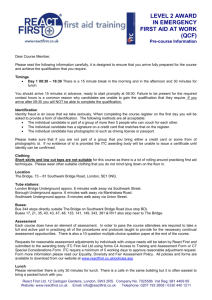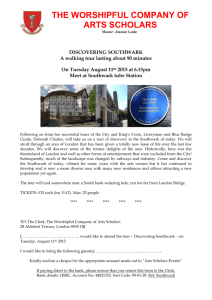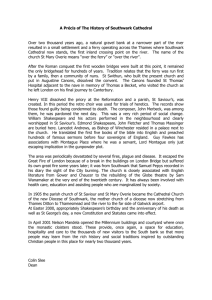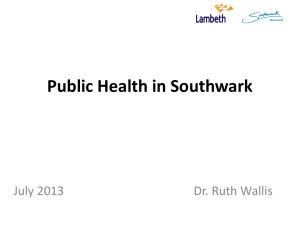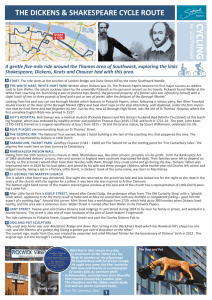here
advertisement
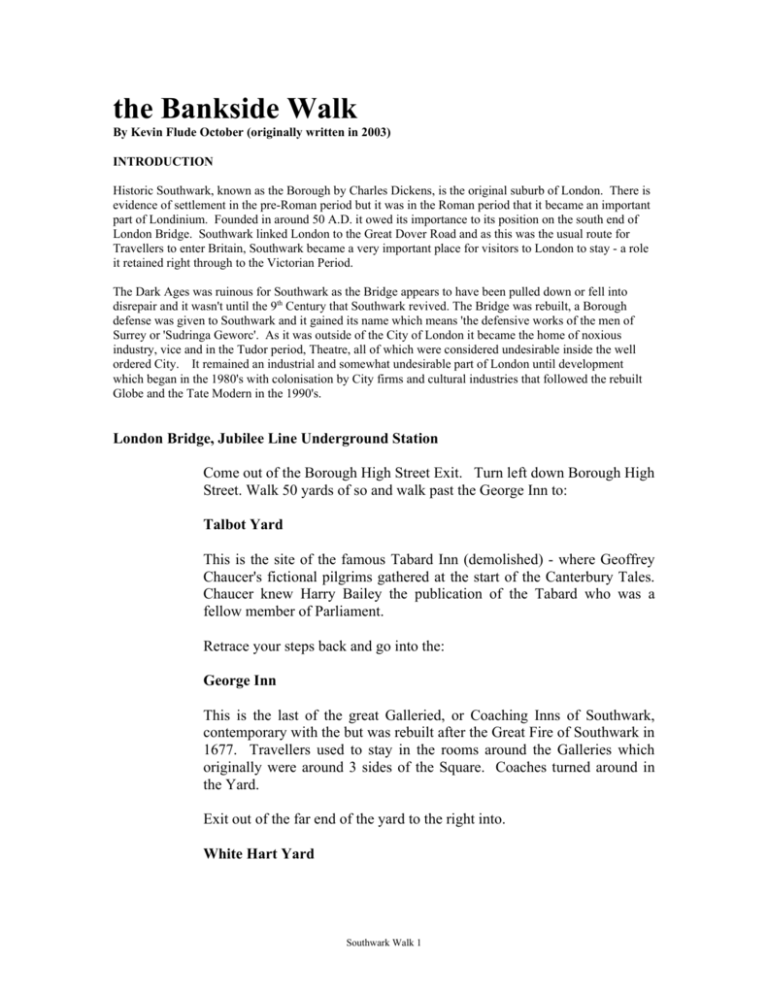
the Bankside Walk By Kevin Flude October (originally written in 2003) INTRODUCTION Historic Southwark, known as the Borough by Charles Dickens, is the original suburb of London. There is evidence of settlement in the pre-Roman period but it was in the Roman period that it became an important part of Londinium. Founded in around 50 A.D. it owed its importance to its position on the south end of London Bridge. Southwark linked London to the Great Dover Road and as this was the usual route for Travellers to enter Britain, Southwark became a very important place for visitors to London to stay - a role it retained right through to the Victorian Period. The Dark Ages was ruinous for Southwark as the Bridge appears to have been pulled down or fell into disrepair and it wasn't until the 9th Century that Southwark revived. The Bridge was rebuilt, a Borough defense was given to Southwark and it gained its name which means 'the defensive works of the men of Surrey or 'Sudringa Geworc'. As it was outside of the City of London it became the home of noxious industry, vice and in the Tudor period, Theatre, all of which were considered undesirable inside the well ordered City. It remained an industrial and somewhat undesirable part of London until development which began in the 1980's with colonisation by City firms and cultural industries that followed the rebuilt Globe and the Tate Modern in the 1990's. London Bridge, Jubilee Line Underground Station Come out of the Borough High Street Exit. Turn left down Borough High Street. Walk 50 yards of so and walk past the George Inn to: Talbot Yard This is the site of the famous Tabard Inn (demolished) - where Geoffrey Chaucer's fictional pilgrims gathered at the start of the Canterbury Tales. Chaucer knew Harry Bailey the publication of the Tabard who was a fellow member of Parliament. Retrace your steps back and go into the: George Inn This is the last of the great Galleried, or Coaching Inns of Southwark, contemporary with the but was rebuilt after the Great Fire of Southwark in 1677. Travellers used to stay in the rooms around the Galleries which originally were around 3 sides of the Square. Coaches turned around in the Yard. Exit out of the far end of the yard to the right into. White Hart Yard Southwark Walk 1 This is the site of the Inn mentioned in Henry VI Part 1 but it is more famous for the first appearance of Sam Weller - the cheeky Cockney in Pickwick Papers. This was Dickens' first venture as a serial fiction writer and it was failing badly until, in the third installment he introduced the Boot Boy of White Hart. Weller took the English-speaking world by storm and Dickens became famous. Walk away from Borough High Street down the Yard towards Guy's Hospital The Hospital was founded by Thomas Guy in 1724, he made a fortune from selling bibles and speculating on the South Sea Company. It was originally for the incurably ill Turn left into the courtyard area: London Bridge Fragment You will be walking between two courtyards - typical 18 th Century Hospital architecture - the colonnades were original open to the elements. On the left is a statue of Lord Nuffield, on the right is a small part of London Bridge, this was one of the shelters for pedestrians on the famous London Bridge that was demolished in 1830 and which is now in Arizona. Continue into the Square now used as a car park at the centre of which is a statue of Thomas Guy, the found of the hospital. Turn left into: Guy's Chapel This is a fine example of a Georgian Chapel, decorated in what might be called Wedgwood Blue. Continue out to St Thomas St., turn left and admire the Georgian terrace on the right - originally part of the old St Thomas' Hospital. Walk to St Thomas Church (1703), now redundant, and walk into the Tower, and climb up the Spiral Staircase into: The Old Operating Theatre Museum and Herb Garret This is an amazing place - an operating theatre (emergency room - built 1822) used in the days before Anaesthesia! Situated in the roof space of the Church it shares the atmospheric space with the Herb Garret where the Hospital apothecary stored his herbal medicines. Southwark Walk 2 On coming out turn right, walk to the end of St Thomas St, cross Borough High Street and go through the arch marked 'Borough Market' Borough Market This market claims to be the oldest market in London as it is the descendant of the market that used to be on London Bridge! On Friday and Saturday it hosts a wonderful 'foodies' market with organic foods and farmers' stalls. Walk through the market to: Southwark Cathedral This used to be a Monastery Church called St Mary Overy, much restored in the Victorian period it is non the less a magnificent Church. Walk past the Cathedral towards Clink Street to: St Mary Overy Dock This Dock was mentioned in the Domesday Book (11th Century) and was where the Bishop of Winchester unloaded his goods. Walk into Clink Street Winchester Palace On the left you will see the end wall of the Bishop of Winchester's Palace - and the remains of a wonderful Rose window and the 3 doors leading from the Great Hall into the Buttery, the Pantry and the Kitchen. Walk down Clink Street to: The Clink Museum and Vinopolis These two museums suit various tastes - the Clink Museum has displays on torture and prostitution while Vinopolis tells the story of Wine. The original clink prison was opposite Vinopolis. Across the road is: The Anchor This was once the 'Castel upon the Hoope' the first of 22 legal Brothels in the medieval period. In the 18th century it was rebuilt and was a pub Southwark Walk 3 owned by the Thrales - friends of the great Dr Johnstone. Mrs. Thrale wrote one of the first biographies of Johnstone. Continue along the Thames, under Southwark Bridge to: The Globe This reconstructed Globe is not on the original site of Shakespeare's Globe, which opened in 1599 just on the other side of Southwark Bridge. After visiting the Exhibition of Shakespearean London continue along the River to: Tate Modern and Millennium Bridge The Museum and the Norman Foster designed Bridge across the Thames are both millennium projects, which have transformed London. After visiting the former Power Station (Giles Gilbert Scot) finish the tour by crossing the Bridge and visiting Wren's fabulous St Paul's Cathedral. Southwark Walk 4

